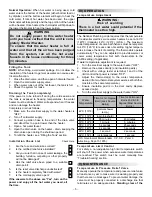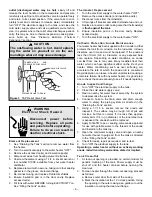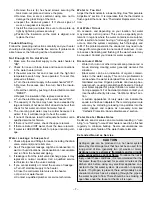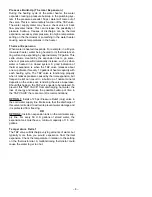
c. Remove the six (6) hex head screws securing the
tank clean-out plate and remove the plate.
d. Remove lime, scale or sediment using care not to
damage the glass lining of the tank.
e. Inspect the clean-out gasket. If it shows signs of
wear, a new gasket is required.
f. Install the clean-out plate. Be sure to draw plate up
tight by tightening screws securely.
g. Position the insulation so the mark is aligned, and
replace the door.
Trouble-Shooting
Follow the preceding instructions carefully and your heater
should provide long and trouble free service. If problems do
arise however, the following will be of assistance:
Not Enough Or No Hot Water
1.
Make sure the electrical supply to the water heater is
"ON".
2.
Check for loose or blown fuses and loose connections
in the water heater circuit.
3.
If the water was too hot and is now cold, the high limit
temperature switch may have operated. To reset this,
proceed as follows:
a. Turn the electrical supply to the water heater "OFF".
b. Remove the access door then turn back the insula-
tion.
c. Reset the control by pushing in the red button marked
'RESET'.
d. Repack the insulation then replace access door.
e. Turn the electrical supply to the water heater "ON".
4.
The capacity of the tank may have been exceeded by
large demands of hot water. Wait at least one hour then
check for hot water at normal hot water faucet.
5.
The incoming cold water may be colder because it is
winter. If so, it will take longer to heat the water.
6.
If none of the above result in adequate hot water, call a
qualified service technician.
7.
If there is no HOT water, check the upper element.
8.
If there is limited HOT water, check the lower element.
9.
If water is LUKEWARM check for proper incoming volt-
age.
Water Leakage Is Suspected
1.
Check all pipes and fittings for leaks, including the drain
valve, element(s) and relief valve.
2.
See if the apparent leakage might be condensation. In
warm or humid locations, condensation can accumulate
and run from the heater and piping.
3.
If leakage is from the relief valve discharge pipe, it may
represent a normal condition. Call a qualified service
technician to check the valve carefully.
4.
If you cannot identify or correct the source of leakage:
a. Turn off electrical supply to he heater.
b. Close the cold water inlet valve to the heater.
c. Open a hot water faucet.
d. Contact a qualified plumber or service technician.
Water Is Too Hot
Adjust the thermostats to a lower setting. See “Temperature
Adjustment” section. It is imperative that the thermostat is
flush against the tank. See “Thermostat Replacement” sec-
tion.
Hot Water Odour
On occasion, and depending on your location, hot water
may develop a strong odour. This can be especially prob-
lematic in regions where the water contains some sulphur,
which results in hot water having a "rotten egg" smell. If this
occurs, drain the system completely, flush thoroughly and
refill. If the problem persists, the anode rod may need to be
changed from magnesium to one made of aluminum. In cer-
tain cases chlorinating and flushing of the water heater may
be required. Contact your dealer or water supplier.
Discoloured Water
·
Water rich in iron or other minerals can produce red or
brown staining. Heating water generally worsens this
situation.
·
Black water can be an indication of organic contami-
nates in the water supply. This can be problematic in
areas where the water is obtained from surface or con-
taminated sources. Organic particles can develop bac-
terial growth, causing potential health hazards. Contact
your water supplier for proper filtration or water condi-
tioning equipment. For bacterial problems contact your
local health authority. Also see “Hot Water Odour” sec-
tion.
·
A sudden appearance of rusty water can indicate the
anode rod has been depleted. The remaining steel core
wire may be corroding, releasing iron particles into the
water. Inspect and replace as necessary. Also see
“Cathodic Protection: Anode Maintenance” section.
Water Heater Makes Noise
Sediment, sand or scale can accumulate resulting in "rum-
bling" or a "hissing" noise. Water heaters need to be flushed
regularly to minimize buildup. Severe accumulations can
cause premature failure of the water heater elements.
Extended Non-Use Service
– 7 –
CAUTION
Hydrogen gas can be produced in a hot water system
served by this storage tank that has not been used for a
long period of time (generally two (2) weeks or more).
Hydrogen gas is extremely flammable and can ignite
when exposed to a spark or flame.
To reduce the risk of
injury under these conditions, it is recommended that the
hot water faucet be opened for several minutes at the
kitchen sink before using any electrical appliance con-
nected to the hot water system. Use caution in opening
faucets. If hydrogen is present, there will probably be an
unusual sound such as air escaping through the pipe as
the water begins to flow. There should be no smoking or
open flame near the faucet at the time it is open.




























